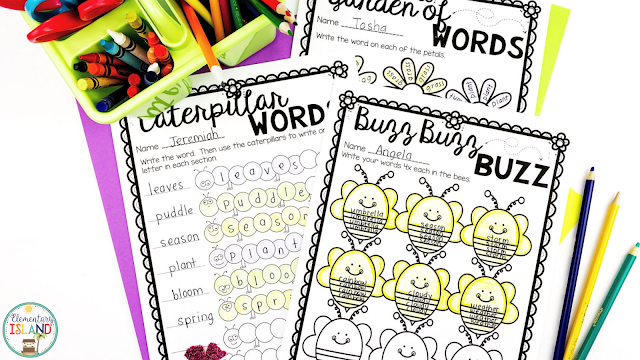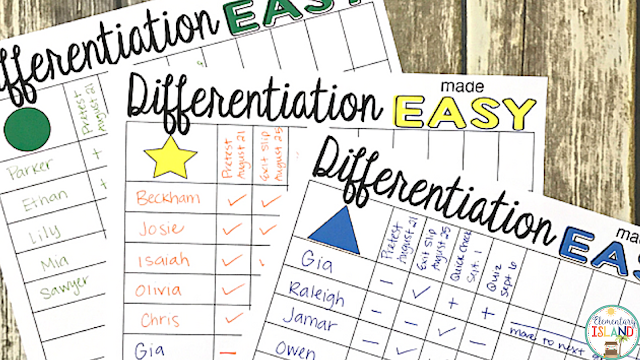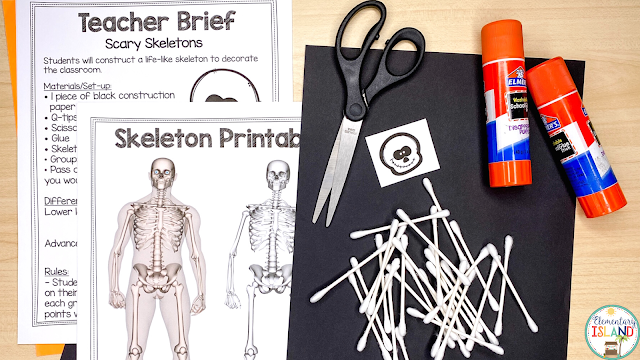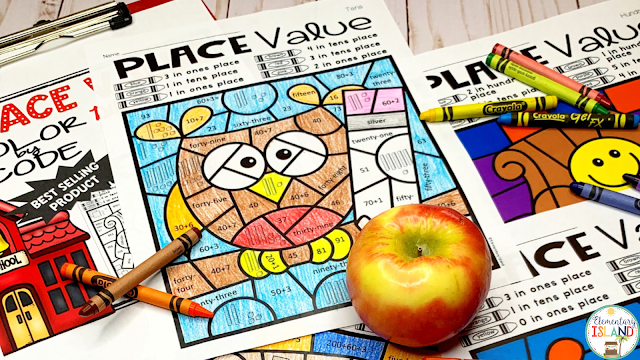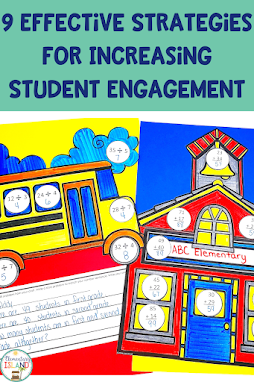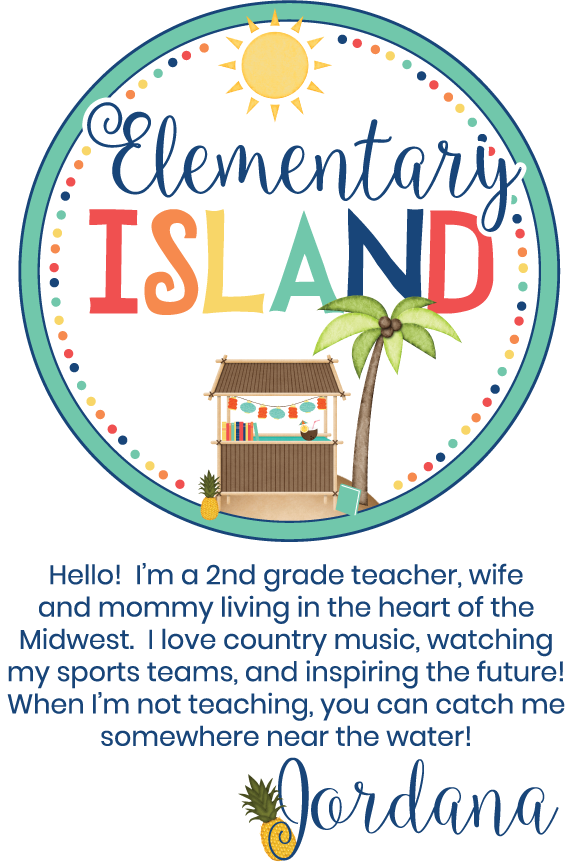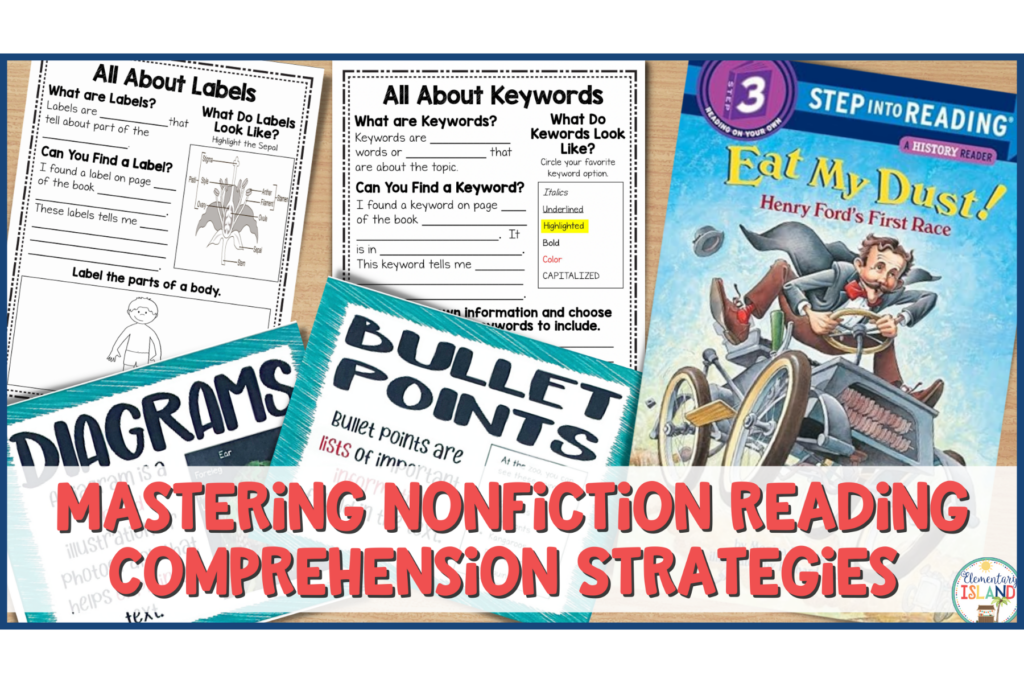As teachers, we know that the more engaged our students are in the lesson, the more learning happens and solidifies. That makes engagement a BIG part of what we do in the classroom. I don’t know about you, but I am tired of feeling like I have to put on a big production just to get students engaged. I decided to spend some time digging into what engaged my students so that I could use more of that. Over time, I’ve found 9 effective strategies for increasing student engagement. And. . . none of them involve a song and dance!
We are all familiar with the excitement and pride we have on the days it feels like we have every student engaged in some way. You caught their attention from the start, and they are actively working on the activities. Plus, the skills and concepts are clicking. That’s a great day in any classroom.
On the flip side, what can you do when engagement seems to be waning? I have nine effective strategies for increasing student engagement that you can pull out anytime you need to pump up the engagement levels!
Strategy #1: Get Students Up and Moving with Task Cards
I look for any opportunity to get my students up and moving around the classroom. I can remember when I was a student, and constantly being concerned about the time because I was ready to move!
My students know that when a new topic or concept is being introduced that they will be sitting. However, they know that I like to move as much as they do, so they also know partnering up or moving around will soon follow the whole class lesson.
When it’s time to practice, one of my favorite ways to have my students move around the room is by using task cards.
Task cards can be used in all subject areas and offer great opportunities for adding movement to an activity.
Before our activity, I will have posted the task cards around the room or in the hallway. This will be the basis of our Write the Room or Scavenger Hunt activity. The only other thing I need is the recording sheets and a bin of clipboards set out for the students to easily grab.
Each student moves to a task card to begin the activity. The first thing they do at each task card is to look for the question number on the card. This will correlate with the number on their answer sheet. Then they read the question and answer the question by writing the answer on the recording page.
The order in which the students complete the task cards changes depending on the size of the group. If a small group is working with task cards, I will let them move at their own pace. When they are finished with a card, they can move to another card as long as they have completed each one by the end.
If the whole class is working with the task cards, I will have the movement be more structured. They will have a certain amount of time to work on the task card, and then they will all move clockwise to the next card.
This is just one way to use task cards! There are SO many more ways you can use task cards as a strategy to increase student engagement! You can learn about
24 more ideas on how to use task cards in your classroom that are fun and engaging for your students!
In the
Elementary Island TPT Store, I have many sets of task cards for Math, English, and Reading. They all have different levels of difficulty to help differentiate for your students as well!
Strategy #2: Encouraging Student Participation with Posters
Another amazing strategy that increases student engagement is a class Seek and Find Challenge. I started this because I wanted to incorporate a way for my students to always be on the lookout for the things we are learning in their day-to-day lives. Not only does it engage students but they also take ownership of their learning.
The Seek and Find Challenge encourages students to look for things they have learned about in class in the books they are reading, TV shows they are watching, or in other day-to-day activities. Whether in class or at home, students are encouraged to write down what they found and post it on the Seek and Find board.
The first time I tried this with my class we were studying word building with prefixes. One day, during a read aloud we came upon a word with a prefix. I stopped and showed students the word and we discussed how it connected to what we were learning in grammar. When the students realized this was a “real life” example they got really excited. I grabbed a sticky note and wrote down the word, underlining the prefix. Then I stuck the note to our Seek and Find poster.
I told the class that if they came across any words in their books, on a billboard, or even on a TV show, they could write it down and add it to the board. At the end of the week, we shared out our discoveries from the poster. I was truly amazed at not only how excited my students were to connect their learning to their daily lives, but they seemed to have a better understanding of prefixes than before.
This might have been the first Seek and Find Challenge, but it definitely wasn’t the last. Now I use them all of the time. The topic of our Seek & Find board is always changing. Sometimes it is math related, like fractions, and other times it might be vocabulary words from our science unit. Whatever you choose, just know that your students are going to become super detectives.
I love seeing the excitement students have as they add a new note to our poster. I’ve also noticed that they improved their communication skills as they explain their note at the end of the week. Each explanation is almost like a mini-lesson that reviews the skill or concept. The Seek and Find Challenge promotes a sense of ownership in learning and helps students take an active role in their education.
Strategy #3: Did Someone Say Digital?
Another effective strategy for increasing student engagement is using digital activities in the classroom. Like it or not, our students are growing up in a digital age, unlike any generation before them. Their entire lives have included technology. Not to mention that they love it!
Incorporating technology and digital learning activities is a surefire way to increase student engagement. I dig further into all the different
benefits of digital activities in the classroom in a previous post. You will find inspiration, well-explained ideas, and a free resource ready to be used in your class today!
A digital resource I enjoy using in my classroom regularly is
BOOM Cards. BOOM Cards are digital task cards. They are a fun and interactive way for students to practice and review different topics and skills. The game-like feel of digital activities makes them exciting for students. Students will happily complete 25 questions using BOOM Cards, but if the same 25 questions were on a traditional worksheet the assignment would be met with moans and groans.
You can also use BOOM Cards and other digital activities as a whole-class warm-up at the beginning of class or whole-class practice during a lesson.
Learn more about the benefits of BOOM Cards by reading
BOOM Cards in the Classroom! Read all the way to the end for a free deck of BOOM cards to try out in your classroom!
Strategy #4: Student Choice Options
An important and effective strategy for increasing student engagement is allowing students to have a choice in what they can do. When students are interested in what they are doing, there will be an increase in work effort and time management. This might include a choice in the activity they complete or a choice in the topic they learn about.
Students can be given a choice in all subject areas. One way I incorporate it in my subject areas is through a Choice Board or Menu. There are various names for it, but basically, it’s a page with 9 options of different activities students can choose from. Activities will vary in length and type of activity (digital, make a poster, write a comic strip, create a song, etc.) Depending on the goal and length of time students have to complete the activity, they are given a set number of menu activities they need to complete.
These choice boards or menus can be used as part of a class assignment, as extension projects, or as activities for early finishers.
One way I incorporate choice is in our
spelling practice. While the goal of each activity remains the same, learn to spell the target words, the activities students can choose from varies. When you need to repeat, repeat, repeat, it’s important to have a variety of activities ready to help keep engagement high amongst your students. I have 12 different spelling activities for them to choose from and students know that they must complete a set number.
Throughout the year, the theme of the activities will change. I find that this helps to bring excitement to these practice activities resulting in higher engagement. My
Spelling Choice Activities are no-prep and work with any spelling word list!
Strategy #5: Differentiate, Differentiate, Differentiate
Every learner learns differently! In today’s classroom, differentiation is key to our students’ success. Differentiation is not a crutch. Instead, it allows you to meet your students where they are and encouragingly provides them an opportunity to be successful. You are providing access to a beneficial educational experience with this strategy.
As teachers, our plates are full, and as a result, differentiation can feel like a daunting task. But it doesn’t have to be! To help streamline the process of differentiation in the classroom, I walk you through a series of tips and steps in
Tips for Making Differentiation Easy. I wrote this post to help you become organized and feel confident to help meet the needs of each of your students!
Strategy #6: Using Student Names in the Classroom
“Hey, you!”
“Who? Me?”
“Yeah, you!”
One of the worst feelings is when someone chooses to not say your name or forgets your name and refers to you as “you.” A person’s name is so important to their identity. As a teacher, you know that addressing your students by name is essential in building positive relationships. When students feel valued and recognized as individuals, they are more willing to build trust and rapport with you.
Using their names creates a personal connection, fosters a sense of belonging, and can increase their engagement in the classroom. Incorporating student names into your teaching and classroom environment can be done in many ways. For example, use name tags or nameplates on desks, assign classroom jobs using their names, or create personalized rewards.
Another way to engage students using their names is to incorporate them into your lessons. Turn boring word problems into pure excitement just by adding in student names. Your students will love to be the star of their own classroom questions. And. . . you don’t even have to write your own questions to do this. Use the questions from your textbook or lesson and just change out the names. You can even make the setting and events line up with things you’ve done as a class.
When students feel valued and respected, they are more likely to pay attention and actively participate in discussions and activities. The engagement and success levels of your students begin with that one simple but powerful decision to use their names.
Strategy #7: Make Cross-Curricular Connections
During my practicums during college, I planned a few cross-curricular lesson plans. I didn’t really start appreciating cross-curricular connections until my first full year of teaching. I remember sitting down with all of my school’s standards and wondering when, where, and how was I going to fit all of these into our 180-day school year.
I quickly realized that making cross-curricular connections was such a powerful way to deepen students’ learning and increase engagement. Added bonus, it made my teaching a little less frenzied knowing I was teaching to several different standards at one time!
Math crafts and STEM activities are a great way to integrate subjects like math, science, art, reading, and writing. For example, students can build the skeletal system using Q-tips or create a math craft where they write about the math they are using.
Any time that I can connect multiple skills or standards in one activity, I feel like I’ve won the teacher time management lottery! So much so, that now my goal is to try and always incorporate multiple skills or standards in my classroom activity. That’s why I created a variety of
math crafts for different holidays. Students can add some holiday learning and fine motor skills to their practice of basic math operations.
STEM activities are also great ways to get students working on multiple skills and concepts at the same time. I was constantly looking for hands-on STEM resources that provided my students an authentic, approachable learning experience when it came to science, technology, engineering, and math. I created
a series of STEM resources that cover a range of STEM-related topics – coding, robotics, chemistry, and physics. These activities are innovative and help to bring these subjects to life by being hands-on and interactive. My students ask me every day when our next STEM activity will be! They love being collaborative with their team members, designing and manipulating the materials for the end goal!
These activities not only make learning more meaningful but also foster critical thinking and problem-solving skills!
Strategy #8: Use Active Response Techniques
Fun student responses are a great way to promote engagement in the classroom. One of the reasons why I love this is because there is no end to your options! And. . . the sillier the better when it comes to keeping students engaged. My advice is to find several that will work for you and have them in your teacher toolbox to rotate through!
One student response I use is to have students complete an action to show which answer they agree with. For example, I have the students touch their noses if they agree with a statement or touch the floor if they disagree. You can easily change up the two things they touch or add a new action. Sometimes I will save this technique for that time in the lesson when attention starts to fall off. So, for the first few minutes, we use our traditional thumbs up or thumbs down. Then out of nowhere, I change it up. I can quickly see who is paying attention and this surprise change usually results in lots of giggles.
Call and response activities are also effective for engagement, active listening, and classroom management. They are so many out there, like:
1, 2, 3 Eyes on Me….1, 2 Eyes on You
Holy Moly…Guacamole
Hocus Pocus…Time to Focus
These types of calls are a great way to get student attention when they have been working independently.
Lastly, I use four corners and whiteboards, especially during review sessions before a test. Each corner of my room will represent an answer choice, such as A, B, C, or D. I will read off the question, and the students will move to the corner with the correct answer.
Allowing students to interact with a lesson using whiteboards is another great way to increase engagement. Each student receives their own whiteboard and marker. They listen to the question being asked, and they write down their response on the whiteboard. I will count down 3, 2, 1, and then say “Flip.” The students will hold up their whiteboards and show me what they wrote. I can quickly look at their responses and see who is understanding and who needs more practice. It’s amazing how excited my students become when they hear, “Please grab a whiteboard.”
These responses not only make learning fun but also promote active listening and critical thinking skills. Keep in mind these are just a few examples of active student response ideas. Anything that allows students to actively participate in the lesson without a traditional pencil and paper activity will help improve engagement. Experiment with them, and see what works best for you and your students!
Strategy #9: Hands-On Activities to Promote Active Learning
Hands-on activities provide an excellent way to promote active learning and engagement. Through my years of teaching, I have observed the power of hands-on activities with my students. It doesn’t matter the age. And. . . the science of learning supports this! Doing results in better learning than just seeing or hearing.
A great example of hands-on learning is STEM activities. The basis of STEM learning is that students are using what they know to build and create. Even if they don’t have a deep understanding of the concepts, the opportunity to plan, create, test, and correct, offers valuable learning opportunities.
Another way I incorporate hands-on learning is through
Color by Code Math Activities. I like to incorporate these pages into one of my math centers. Students are free to use any available math manipulatives as they solve the problems. Then, instead of writing the answer, they color the space with the correct color. The students love that they don’t have to write their answers in the traditional way. My students love these pages because they enjoy trying to figure out what the picture is, and I love that they are getting in key math skills practice!
BONUS Strategy: Songs and Chants
Sometimes my students have a difficult time remembering a new concept. I often feel that this can happen when they aren’t actively engaged in the lessons. When this happens I know it is time to tap into my inner rock star. Just kidding – but not really. Making up songs or chants is a great way to engage students and help them remember. There’s something about the rhythm that just reaches the brain differently.
Not sure where to start? Choose a common tune that the kids know or try the “I don’t know but I’ve been told” military cadence. Write your own version to help students remember the concepts they have been learning.
Here’s an example that I have used in my classroom when working on place value models.
Teacher: I don’t know but I’ve been told
Students: I don’t know but I’ve been told
Teacher: Tens are tall and ones are small
Students: Tens are tall and ones are small
Teacher: Then hundreds are after that
Students: Then hundreds are after that
Teacher: They are round and they are fat
Students: They are round and they are fat
Add some hand motions to the words and you’ve got a multi-sensory, interactive learning song that your students will be fully engaged with and aren’t soon to forget!
Looking for More Engagement Ideas?
If you are looking for even more engagement ideas, then check out the blog post
Activities to Engage Students Now. In this post, you will learn more ways to increase student engagement. Plus you can grab a freebie too!
Every group of students will respond to different engagement strategies. Have a variety in your teacher toolbox and you’ll be ready to engage all year long.
Save for the Future!
Remember to pin this post to your favorite classroom Pinterest board so you can come back any time you need student engagement ideas!






